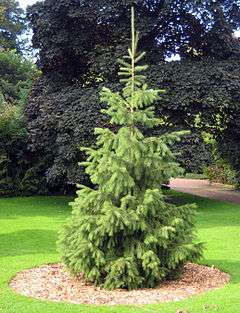Picea smithiana
| Morinda Spruce Picea smithiana | |
|---|---|
 | |
| Morinda Spruce at Royal Botanic Garden Edinburgh | |
| Scientific classification | |
| Kingdom: | Plantae |
| Division: | Pinophyta |
| Class: | Pinopsida |
| Order: | Pinales |
| Family: | Pinaceae |
| Genus: | Picea |
| Species: | P. smithiana |
| Binomial name | |
| Picea smithiana (Wall.) Boiss. | |
Picea smithiana, the Morinda spruce[1] or West Himalayan spruce, is a spruce native to the western Himalaya and adjacent mountains, from northeast Afghanistan east, India to central Nepal. It grows at altitudes of 2,400-3,600 m in forests together with deodar cedar, blue pine and pindrow fir.
Description
Picea smithiana is a large evergreen tree growing to 40–55 m tall (exceptionally to 60 m), and with a trunk diameter of up to 1–2 m. It has a conical crown with level branches and usually pendulous branchlets.
The shoots are pale buff-brown, and glabrous (hairless). The leaves are needle-like, the longest of any spruce, 3–5 cm long, rhombic in cross-section, mid-green with inconspicuous stomatal lines. The cones are broad cylindric-conic, 9–16 cm long and 3 cm broad, green when young, maturing buff-brown and opening to 5–6 cm broad 5–7 months after pollination; the scales are stiff and smoothly rounded.
Morinda spruce is a popular ornamental tree in large gardens in western Europe for its attractive pendulous branchlets. It is also grown to a small extent in forestry for timber and paper production, though its slower growth compared to Norway spruce reduces its importance outside of its native range. The name morinda derives from the tree's name in Nepali.
References
- ↑ "BSBI List 2007". Botanical Society of Britain and Ireland. Archived from the original (xls) on 2015-02-25. Retrieved 2014-10-17.
- Conifer Specialist Group (1998). "Picea smithiana". IUCN Red List of Threatened Species. Version 2006. International Union for Conservation of Nature. Retrieved 6 May 2006.
